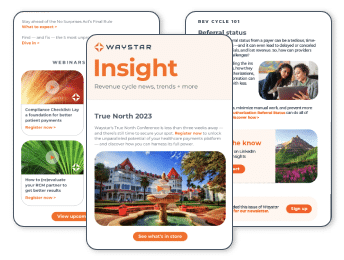It used to be enough to render services, collect a copay, submit claims, and bill the patient. But due to changing consumer expectations and the rise of high deductibles, this billing model is quickly becoming outdated.
According to research from FierceHealthcare, patient satisfaction ratings fall by an average of 30% during the billing cycle. In 2017, TransUnion reported 68% of consumers were unable to pay after services were provided, and they expect that to rise to 95% in 2020.
It’s clear that patient collections will grow both in importance and, unfortunately, in difficulty. Here are three ways you can maximize patient collections.
1. Exceed patient expectations with online bill pay
According to a 2019 consumer survey, 49% of patients expressed frustration with the lack of digital options for paying bills, and 45% rated the post-visit experience (including billing, insurance, and follow up) as the worst part of the patient journey.
In fact, a poor digital experience could mean a dwindling patient pool altogether. Consumers aged 18-34 said they were 3X as likely to consider switching providers over a bad online experience. Offering your patients flexible payment options, such as convenient online payment processing, makes your patients much more likely to pay their portion of the bill.
Moreover, healthcare organizations can influence patient payments by recommending a default payment or suggesting patients pay a larger portion of their bill in fewer installments.
2. Reduce costs with self-service estimates
A Healthcare Consumer Study revealed 60% of consumers seek out-of-pocket estimates prior to their visit. If a patient is informed about the financial process, has options in paying for care, and has someone they know to go to with any questions they might have, they are less likely to throw the ball into a stack and forget about it. A good financial counseling program can increase patient satisfaction and collection rates while decreasing back-end expenses.
Patients shouldn’t have to call to find out their expected out-of-pocket responsibility, and your staff shouldn’t have to waste valuable time hunting down said patient’s current individual coverage to generate an accurate estimate.
That’s where automation comes in.
Embedding a self-service web application directly into your website allows patients to automatically pull an individually tailored estimate from their most currently available levels of coverage, significantly reducing staff hours (and corresponding costs) and increasing your likelihood of payment.
3. Optimize staff collection efforts with analytics
You may be facing high-balance accounts with a low propensity to pay or low-balance accounts with a high propensity to pay.
Propensity to pay automation allows you to supercharge your limited resources and re-focus your team away from high-volume, low-reward work to only work the accounts that matter.
Propensity to pay analytics help to identify which account balances will be hard to collect and which won’t, and calculates the chance of the account being paid out compared to the collections you will receive for said work effort. Gone are the days of staff opening their work queues to crank away on the first account that pops up.
Moreover, strategic use of analytics, like propensity to pay and financial aid determination, supports a personalized financial experience for patients, ultimately resulting in improved collections.
The wrap up
Healthcare is changing. The way we do business needs to change, too.
And as people continue to shop around for the best healthcare experience, you need to do everything you can to make sure your organization is at the top of their list. That means moving towards a modern, patient-centric model that is not only equipped for patient payment collection but encourages it.


